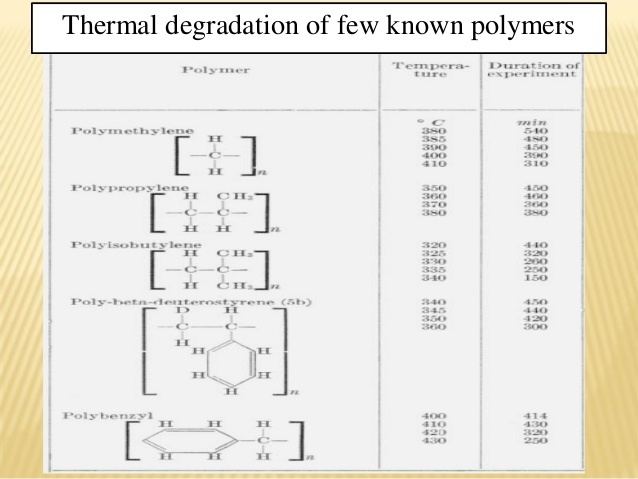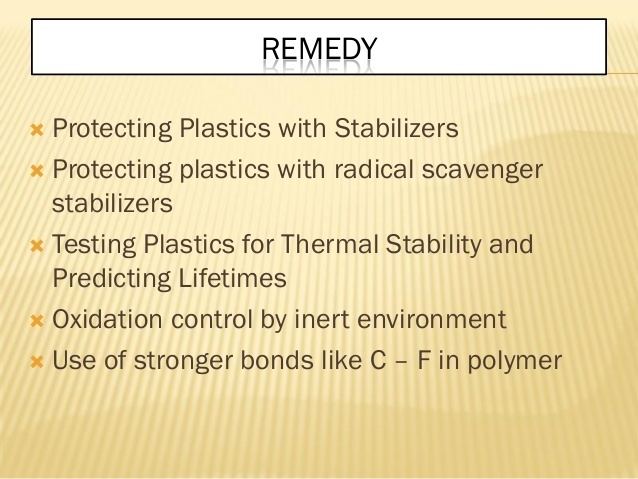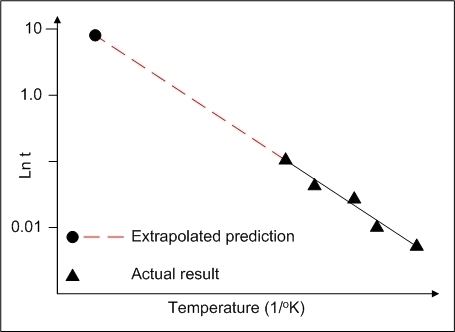 | ||
Thermal degradation of polymers is molecular deterioration as a result of overheating. At high temperatures the components of the long chain backbone of the polymer can begin to be broken (chain scission) and react with one another to change the properties of the polymer. Thermal degradation can present an upper limit to the service temperature of plastics as much as the possibility of mechanical property loss. Indeed unless correctly prevented, significant thermal degradation can occur at temperatures much lower than those at which mechanical failure is likely to occur. The chemical reactions involved in thermal degradation lead to physical and optical property changes relative to the initially specified properties. Thermal degradation generally involves changes to the molecular weight (and molecular weight distribution) of the polymer and typical property changes include reduced ductility and embrittlement, chalking, color changes, cracking, general reduction in most other desirable physical properties. Thermal breakdown products may include a complex mixture of compounds, including but not limited to carbon monoxide, ammonia, aliphatic amines, ketones, nitriles, and hydrogen cyanide, which may be flammable, toxic and/or irritating. The specific materials generated will vary depending on the additives and colorants used, specific temperature, time of exposure and other immediate environmental factors.
Contents
- The mechanism of thermal degradation
- Initiation
- Propagation
- Termination
- TGA
- DTA and DSC
- Depolymerisation
- Random chain scission
- Side group elimination
- Oxidation of the polymer
- References

The mechanism of thermal degradation

Most types of degradation follow a similar basic pattern. The conventional model for thermal degradation is that of an auto-oxidation process which involves the major steps of initiation, propagation, branching, and termination.
Initiation

The initiation of thermal degradation involves the loss of a hydrogen atom from the polymer chain as a result of energy input from heat or light. This creates a highly reactive and unstable polymer ‘free radical’ (R•) and a hydrogen atom with an unpaired electron (H•).
Propagation

The propagation of thermal degradation can involve a variety of reactions and one of these is where the free radical (R•) reacts with an oxygen (O2) molecule to form a peroxy radical (ROO•) which can then remove a hydrogen atom from another polymer chain to form a hydroperoxide (ROOH) and so regenerate the free radical (R•). The hydroperoxide can then split into two new free radicals, (RO•) + (•OH), which will continue to propagate the reaction to other polymer molecules. The process can therefore accelerate depending on how easy it is to remove the hydrogen from the polymer chain.
Termination

The termination of thermal degradation is achieved by ‘mopping up’ the free radicals to create inert products. This can occur naturally by combining free radicals or it can be assisted by using stabilizers in the plastic.
TGA

(Thermogravimetric analysis) (TGA) refers to the techniques where a sample is heated in a controlled atmosphere at a defined heating rate whilst the sample's mass is measured. When a polymer sample degrades, its mass decreases due to the production of gaseous products like carbon monoxide, water vapour and carbon dioxide.
DTA and DSC
(Differential thermal analysis) (DTA) and (differential scanning calorimetry) (DSC): Analyzing the heating effect of polymer during the physical changes in terms of glass transition, melting, and so on. These techniques measure the heat flow associated with oxidation.
Depolymerisation
Under thermal effect, the end of polymer chain departs, and forms low free radical which has low activity. Then according to the chain reaction mechanism, the polymer loses the monomer one by one. However, the molecular chain doesn’t change a lot in a short time. The reaction is shown below. This process is common for polymethymethacrylate (perspex).
CH2-C(CH3)COOCH3-CH2-C*(CH3)COOCH3→CH2-C*(CH3)COOCH3 + CH2=C(CH3)COOCH3
Random chain scission
The backbone will break down randomly, this can occur at any position of the backbone, as a result the molecular weight decreases rapidly. As new free radicals with high reactivity are formed, monomers cannot be a product of this reaction, also intermolecular chain transfer and disproportion termination reactions can occur.
CH2-CH2-CH2-CH2-CH2-CH2-CH2’→ CH2-CH2-CH=CH2 + CH3-CH2-CH2’ or CH2’+CH2=CH-CH2-CH2-CH2-CH3
Side-group elimination
Groups that are attached to the side of the backbone are held by bonds which are weaker than the bonds connecting the chain. When the polymer is heated, the side groups are stripped off from the chain before it is broken into smaller pieces. For example the PVC eliminates HCl, under 100–120 °C.
CH2(Cl)CHCH2CH(Cl)→CH=CH-CH=CH+2HCl
Oxidation of the polymer
Polyphenylene oxide is well known for oxidation. This can be viewed as follows.
